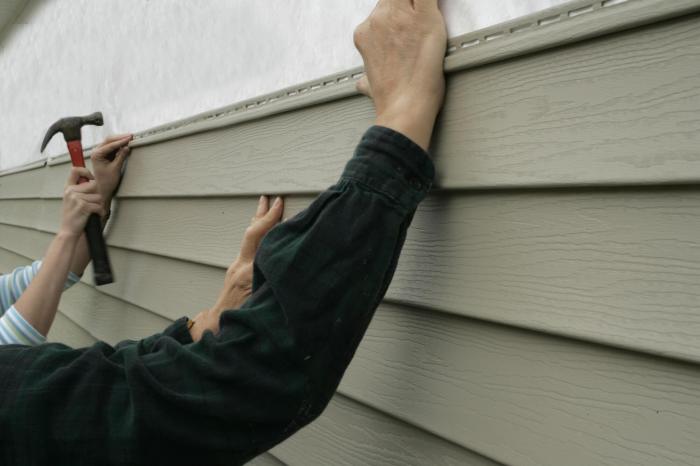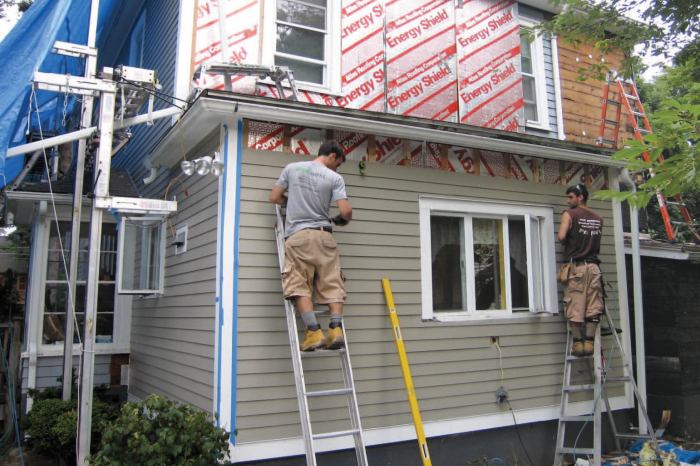Fixing Siding on a House: A Comprehensive Guide
Embarking on the journey of fixing siding on a house opens up a world of possibilities and challenges. From understanding the importance of siding to mastering the art of repairs, this guide will equip you with the knowledge needed to tackle any siding project with confidence.
Understanding Siding
Siding is the exterior material applied to the walls of a house to protect it from the elements and enhance its aesthetic appeal. It serves as a protective barrier against moisture, wind, and other environmental factors, while also providing insulation to improve energy efficiency.
Types of Siding
- Vinyl Siding: One of the most popular choices due to its affordability, low maintenance, and wide range of colors and styles.
- Wood Siding: Offers a traditional and natural look, but requires more maintenance to prevent rot and insect damage.
- Fiber Cement Siding: Durable and resistant to fire, insects, and rot, making it a long-lasting option.
- Aluminum Siding: Known for its durability and resistance to rust, but can dent easily.
- Brick Siding: Provides a classic and elegant appearance, with excellent durability and low maintenance.
Importance of Siding Maintenance
Regular maintenance of siding is crucial for the overall health of a house. Properly maintained siding can prevent water infiltration, mold growth, and structural damage. It also helps in preserving the curb appeal and value of the property. Inspecting and repairing any damage to the siding promptly can extend its lifespan and protect the integrity of the home.
Signs of Damaged Siding

Damaged siding can have a variety of visual indicators that homeowners should be aware of to prevent further issues.
Common Signs of Damaged Siding
- Cracks: Small or large cracks in the siding can be a clear sign of damage, allowing moisture to seep in and cause further deterioration.
- Warping: Siding that appears warped or buckled may indicate water damage or improper installation.
- Discoloration: Streaks or patches of discoloration on the siding can be a sign of mold, mildew, or water infiltration.
Impact of Weather Conditions
Weather conditions play a significant role in the deterioration of siding. Extreme temperatures, heavy rain, snow, and high winds can all take a toll on the durability of siding materials.
Effects of Damaged Siding
- Moisture Penetration: Cracks or warping in siding can allow moisture to seep into the walls, leading to mold growth, rot, and structural damage.
- Insulation Problems: Damaged siding can compromise the insulation of the house, causing energy inefficiency and higher heating or cooling costs.
Tools and Materials Needed
When it comes to fixing siding on a house, having the right tools and materials is essential for a successful project. Here is a list of essential items you will need:
Tools Required:
- Siding removal tool
- Hammer
- Nails or screws
- Tape measure
- Caulk gun
- Ladder
- Level
- Saw
- Gloves
- Safety glasses
- Dust mask
- Utility knife
- Chalk line
Materials Needed:
- New siding panels or pieces
- Caulk
- Paint or stain (if needed)
- Primer
- House wrap (if necessary)
- Flashing tape
- Trim pieces
- Wood filler
- Sandpaper
- Primer
- Paintbrush or roller
Safety Equipment:
- Safety glasses
- Gloves
- Dust mask
- Work boots
- Helmet (if working at heights)
- Ear protection
Preparation Before Fixing
Before beginning the process of fixing siding on a house, it is crucial to properly prepare the work area to ensure a smooth and safe repair job. This involves steps to safeguard the surrounding environment, safely remove damaged siding, and thoroughly inspect the underlying structure for any additional damage.
Protecting the Work Area
- Clear the area around the damaged siding of any furniture, decorations, or obstacles to provide ample space for work.
- Cover nearby plants, bushes, or landscaping with a tarp or plastic sheeting to prevent any debris or damage during the repair process.
- Secure any outdoor pets or animals in a safe location away from the work area to avoid accidents or injuries.
Safely Removing Damaged Siding
- Start by carefully prying off the damaged siding using a pry bar or hammer, being cautious not to cause further harm to the surrounding siding.
- Work slowly and methodically to avoid creating additional damage to the siding or the underlying structure of the house.
- Dispose of the removed siding properly to maintain a clean and organized work area throughout the repair process.
Inspecting the Underlying Structure
- After removing the damaged siding, inspect the underlying structure for any signs of water damage, rot, or mold that may have developed due to the compromised siding.
- Check for any loose or missing fasteners, insulation issues, or other structural problems that may need to be addressed before installing new siding.
- Address any additional damage promptly to ensure a long-lasting and effective repair that protects the integrity of the house.
Repairing Siding
When it comes to repairing siding, it's essential to address minor damages promptly to prevent further issues. Whether you're fixing small cracks or replacing entire sections, following the right steps will help maintain the integrity of your home's exterior.
Repairing Minor Damages
- Clean the damaged area: Start by removing any dirt or debris from the affected siding.
- Apply caulk or sealant: Fill in cracks or gaps with an appropriate caulk or sealant to prevent moisture from seeping in.
- Paint or seal: Once the caulk is dry, paint or seal the repaired area to match the existing siding color.
Replacing Entire Sections
- Measure and cut: Determine the size of the damaged section and carefully cut out the affected area using a saw.
- Remove the old siding: Take out the damaged siding, making sure to detach it from surrounding pieces without causing further damage.
- Install new siding: Cut the replacement piece to size and secure it in place using nails or screws.
Matching New Siding
- Identify siding type: Determine the type and color of your existing siding to find a match for the replacement piece.
- Consult a professional: If unsure about matching the siding, seek advice from a siding expert or supplier.
- Blend and paint: Use paint or stain to blend the new siding with the old, ensuring a seamless look across your home's exterior.
Painting and Finishing

After repairing the siding on your house, the next step is to paint and finish it to protect it from the elements and give it a fresh, new look.
Choosing the Right Paint Color and Finish
When choosing a paint color for your siding, consider the overall aesthetic of your home and the surrounding landscape. Neutral colors like beige, gray, or white are versatile and can complement various architectural styles. As for the finish, opt for a high-quality exterior paint that is specifically formulated for siding to ensure durability and weather resistance.
Applying Paint Properly
- Clean the siding surface thoroughly to remove any dirt, dust, or debris that could affect the paint adhesion.
- Apply a coat of primer to improve paint adhesion and enhance color vibrancy.
- Use a high-quality paintbrush or roller to apply the paint in smooth, even strokes. Consider using a paint sprayer for larger areas for a more uniform finish.
- Allow the first coat to dry completely before applying a second coat for better coverage and protection.
- Follow the manufacturer's instructions for drying time and curing process to ensure a long-lasting finish.
Maintenance and Longevity
Regular maintenance is crucial for ensuring the longevity of your siding. By following some best practices and keeping an eye out for any signs of damage, you can effectively prolong the lifespan of your siding.
Regular Inspections
- Inspect your siding at least once a year to check for any cracks, holes, or signs of moisture damage.
- Look for mold, mildew, or insect infestations that could indicate underlying issues.
- Check for any loose or missing pieces of siding that may need to be repaired or replaced.
Protecting Siding
- Trim nearby trees and bushes to prevent branches from scratching or damaging the siding.
- Keep gutters clean and free of debris to prevent water from seeping behind the siding.
- Avoid using pressure washers at high settings, as they can damage the siding's surface.
Final Thoughts

As we wrap up our discussion on fixing siding on a house, remember that proper maintenance and care are key to ensuring the longevity of your siding. By following the steps Artikeld in this guide, you'll be well on your way to a well-protected and visually appealing home.
Key Questions Answered
What are the most common types of siding used on houses?
Common types of siding include vinyl, wood, fiber cement, and metal. Each material has its own advantages and considerations when it comes to installation and maintenance.
How can I prevent moisture penetration through siding?
Ensuring that siding is properly installed and maintained, including addressing any cracks or gaps, can help prevent moisture from seeping through and causing damage to the house's structure.
Is it necessary to match new siding with the existing siding for repairs?
While matching new siding with the existing one can create a seamless look, it's not always essential. Focus on ensuring that the new siding is compatible in terms of material and style to maintain the overall aesthetic appeal of the house.




